
A Research Grade Alkaline Water Electrolysis Stack with a 25 cm²/unit circular electrode is a specialized setup used in electrochemical research, focusing on hydrogen production through water electrolysis. This system features a porous PPS membrane and nickel alloy catalyst-coated electrodes. Below is a comprehensive overview, including details on series and parallel configurations within the stack:
Stack Configuration: The stack can be configured with multiple cells, either in series (to increase voltage) or parallel (to increase current capacity), depending on the specific research objectives and desired electrical characteristics. The stacks are shipped out in series unless otherwise specified.
Catalyst Performance: Nickel alloy catalysts are valued for their effectiveness in alkaline environments, offering a balance between cost and catalytic efficiency.
Functionality: The porous membrane improves ion transport, reduces ohmic resistance, and enhances the overall efficiency of the electrolysis process, all while maintaining the purity of the gases produced.
Temperature Control: The electrolyte is often maintained at elevated temperatures (60-90°C) to improve reaction kinetics and overall efficiency.
Voltage Monitoring: The voltage across each cell is closely monitored to study overpotentials and the efficiency of the water-splitting process.
Series Configuration (default):
Parallel Configuration:
Current Distribution: Ensuring equal current distribution across cells is essential to prevent hotspots and ensure uniform performance across the stack.
Pressure Control: The system can operate at atmospheric pressure or under slightly elevated pressures, depending on the research objectives. Operating under pressure can increase the solubility of gases in the electrolyte and impact overall efficiency.
Durability Studies: Long-term testing is conducted to study the degradation mechanisms of the nickel alloy-coated electrodes and the PPS membrane, providing insights into the development of commercially viable electrolysis systems.
Stack Configuration: The choice between series and parallel configurations allows researchers to tailor the system’s performance to specific experimental goals, whether focusing on voltage behavior, current density, or overall gas production.
Electrolyte Handling: The caustic nature of the alkaline electrolyte necessitates the use of proper personal protective equipment (PPE) and strict adherence to safety protocols.
In summary, this Research Grade Alkaline Water Electrolysis Stack with a 25 cm²/unit circular electrode and porous PPS membrane is a sophisticated tool for studying the electrochemical processes involved in water splitting. The system’s flexibility in series or parallel configurations makes it invaluable for optimizing material performance and developing more efficient and cost-effective hydrogen production technologies.
| Accessories | ||||
Product image |
AWE25AC-1cell (SS) |
AWE25AC-1cell (epoxy) |
AWE25AC-1cell (SS observable) | |
| Tube |
Teflon tube (ID1/16" OD1/8") (USD$10/m) |
Corrosion resistant tube for peristaltic pump (ID1.6mm/OD4.8mm) (USD$50/m) | ||
| Connectors |
PTFE bolts (ID1/8"), $15/set |
PTFE bolts (ID1/8"), $20/set |
Nickel bolts (ID1/8"), $20/set | |
| Others | 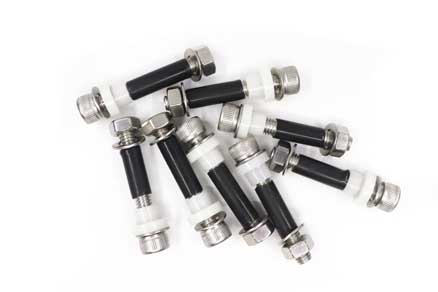 Tighten insulation set (FKM), USD10/pc |
SS springs, $2/set |
Torque wrench with sleeve (1-25 Nm), $100/set | |
25A High current DC electrical lead pair - Alligator Clip $10/pair/0.5m; $15/pair/1m $20/pair/1.5m; $25/pair/2m |
25A High current DC electrical lead pair - Banana plug to Alligator Clip $10/pair/0.5m; $15/pair/1m $20/pair/1.5m; $25/pair/2m |
35A High current DC electrical lead pair - Banana plug to Alligator Clip $15/pair/0.5m; 20/pair/1m $25/pair/1.5m; $30/pair/2m |
40A High current DC electrical lead pair - Ring to Ring $20/pair/0.5m; 25/pair/1m $30/pair/1.5m; $35/pair/2m | |
Temperature controller, $699 (Accuracy: 0.1°C) | Heating pads ($180/pair) Heating pad binder, $50/25ml |
Wrench kit, $10/set | ||
VHP01 vacuum heater | A simple system for electrolyte circulation and gas-liquid separation, $500 | Small peristaltic pump, $300/pc Standard peristaltic pump, $400/pc Standard peristaltic pump with two channels, $700/pc Gear pump, $700/pc | DC power supply with data recording, storage, and export functions, $1000/pc | |
PP isodiametric barbed hose connector Hose IDΦ1-Φ1.6mm, USD$2/pc Hose IDΦ1.6-Φ2.4mm,USD$2/pc Hose IDΦ2.4-Φ3.2mm,USD$2/pc Hose IDΦ3.2-Φ4mm, USD$2/pc |
PP barbed connector for variable diameter hoses Hose IDΦ1.6↔Φ2.4, USD$2/pc Hose IDΦ1.6↔Φ3.2,USD$2/pc Hose IDΦ2.4↔Φ3.2, USD$2/pc Hose IDΦ2.4↔Φ4,USD$2/pc Hose IDΦ3.2↔Φ4, USD$2/pc |
PE isodiametric quick connector Tube ODΦ3-Φ3mm, USD$2/pc Tube ODΦ3.2-Φ3.2mm,USD$2/pc Tube ODΦ4-Φ4mm, USD$2/pc Tube ODΦ6-Φ6mm,USD$2/pc | ||
PE quick connector for variable diameter tubes Tube ODΦ3-Φ3.2mm, USD$2/pc Tube ODΦ3-Φ4mm, USD$2/pc Tube ODΦ3-Φ5mm, USD$2/pc Tube ODΦ3-Φ6mm, USD$2/pc Tube ODΦ3.2-Φ4mm, USD$2/pc Tube ODΦ3.2-Φ6mm, USD$2/pc | 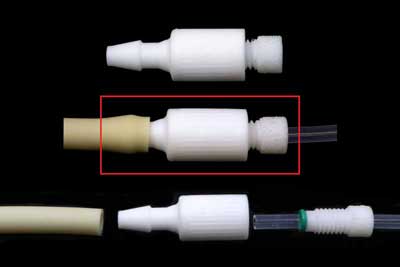 PTFE corrosion-resistant hose/tube adapter Tube ODΦ3.2mm↔hose IDΦ1.6mm, USD$10/pc Tube ODΦ3.2mm↔hose IDΦ2.4mm, USD$10/pc Tube ODΦ3.2mm↔hose IDΦ3.2mm, USD$10/pc Tube ODΦ3.2mm↔hose IDΦ4mm, USD$10/pc |
PTFE corrosion-resistant isodiametric tube connector Φ3mm↔Φ3mm, USD$10/pc Φ3.2mm↔Φ3.2mm, USD$10/pc Φ4mm↔Φ4mm, USD$10/pc Φ6mm↔Φ6mm, USD$15/pc Φ8mm↔Φ8mm, USD$15/p |
PTFE corrosion-resistant connector for variable diameter tubes Φ3mm↔Φ3.2mm, USD$15/pc Φ3mm↔Φ4mm, USD$15/pc Φ3mm↔Φ6mm, USD$15/pc Φ3.2mm↔Φ4mm, USD$15/pc Φ4mm↔Φ6mm, USD$15/pc | |
316L SS isodiametric tube connector Φ3mm↔Φ3mm, USD20/pc Φ3.2mm↔Φ3.2mm, USD20/pc Φ4mm↔Φ4mm, USD20/pc Φ6mm↔Φ6mm, USD20/pc Φ8mm↔Φ8mm, USD20/pc | 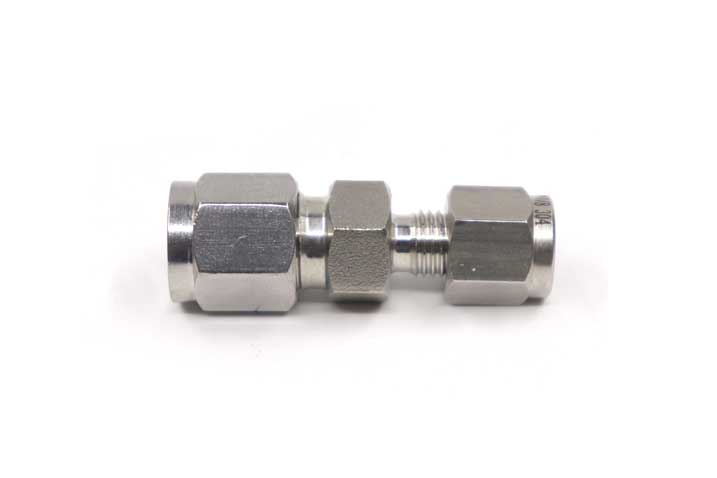 316L SS connector for variable diameter tubes Φ3mm↔Φ3.2mm, USD30/pc Φ3mm↔Φ4mm, USD30/pc Φ3mm↔Φ6mm, USD30/pc Φ4mm↔Φ6mm, USD30/pc |
Electrolyte - Gas Separator PMMA body: USD$799 PTFE body: USD$899 PEEK body: USD$999 | ||
| Consumables | ||||
| Membrane | AEL200 | |||
| Ionomer | Fumion FAA-3 5wt% in ethanol | |||
| GDL | Youveim® Ni fiber paper | DM SS fiber paper Youveim® SS fiber paper | DiffuCarb® CP-A210R raw carbon paper DiffuCarb® CP-A330R raw carbon paper DiffuCarb® CP-A400R raw carbon paper DiffuCarb® CP-H450R raw carbon paper DiffuCarb® CP-H850R raw carbon paper | Youveim® Ti fiber paper Youveim® Ti screen Youveim® Platinized Ti fiber paper Youveim® Platinized Ti screen |
Anode GDE | NiFeOx | |||
| DM NiFeOx-SS fiber paper Youveim® E100H NiFeOx-SS fiber paper with hydrophilic interface Youveim® E100T NiFeOx-SS fiber paper with hydrophobic interface Youveim® E100G NiFeOx-Gold Plated SS fiber paper with hydrophobic interface | Youveim® E102 NiFeOx-Ti Fiber Paper Youveim® E102PT NiFeOx-Platinized Ti Fiber Paper | |||
Youveim® E103 NiFeOx-Ni Fiber Paper Youveim® E103G NiFeOx-Gold Plated Ni Fiber Paper Youveim® E103PT NiFeOx-Platinized Ni Fiber Paper | Youveim® E104 NiFeOx-Ni Foam Youveim® E104G NiFeOx-Gold Plated Ni Foam Youveim® E104PT NiFeOx-Platinized Ni Foam | |||
| CoFeOx | ||||
Youveim® E110H CoFeOx-SS fiber paper with hydrophilic interface Youveim® E110T CoFeOx-SS fiber paper with hydrophobic interface Youveim® E110G CoFeOx-Gold Plated SS fiber paper with hydrophobic interface | Youveim® E112 CoFeOx-Ti Fiber Paper Youveim® E112PT CoFeOx-Platinized Ti Fiber Paper | |||
Youveim® E113 CoFeOx-Ni Fiber Paper Youveim® E113G CoFeOx-Gold Plated Ni Fiber Paper Youveim® E113PT CoFeOx-Platinized Ni Fiber Paper | Youveim® E114 CoFeOx-Ni Foam Youveim® E114G CoFeOx-Gold Plated Ni Foam Youveim® E114PT CoFeOx-Platinized Ni Foam | |||
| IrO2 | ||||
| DM IrO2-carbon paper DiffuCarb® E300 IrO2-carbon paper DiffuCarb® E300T IrO2-carbon paper with hydrophobic interface DiffuCarb® E300H IrO2-carbon paper with hydrophilic interface | Youveim® E301T IrO2-SS fiber paper with hydrophobic interface Youveim® E301H IrO2-SS fiber paper with hydrophilic interface Youveim® E301PT IrO2-Platinized SS fiber paper Youveim® E301G IrO2-Gold Plated SS fiber paper | |||
Youveim® E303T IrO2-Ti fiber paper with hydrophobic interface Youveim® E303H IrO2-Ti fiber paper with hydrophilic interface Youveim® E303PT IrO2-Platinized Ti fiber paper Youveim® E303G IrO2-Gold Plated Ti fiber paper | Youveim® E305T IrO2-Nickel fiber paper with hydrophobic interface Youveim® E305H IrO2-Nickel fiber paper with hydrophilic interface Youveim® E305PT IrO2-Platinized Nickel fiber paper Youveim® E305G IrO2-Gold Plated Nickel fiber paper | |||
Youveim® E309 IrO2/Ti fiber paper Youveim® E310 IrO2/Platinized Ti fiber paper Youveim® E311 Pt-IrO2/Platinized Ti fiber paper | Youveim® E314 IrO2/Ti screen Youveim® E315 IrO2/Platinized Ti screen Youveim® E316 Pt-IrO2/Platinized Ti screen | |||
| Youveim® E320 IrO2/Ti foam Youveim® E321 IrO2/Platinized Ti foam Youveim® E322 Pt-IrO2/Platinized Ti foam | ||||
DiffuCarb® E330 Ir-carbon paper DiffuCarb® E330T Ir-carbon paper with hydrophobic interface DiffuCarb® E330H Ir-carbon paper with hydrophilic interface | Youveim® E340T Ir-Ti fiber paper with hydrophobic interface Youveim® E340H Ir-Ti fiber paper with hydrophilic interface Youveim® E341T Ir-Platinized Ti fiber paper with hydrophobic interface Youveim® E341H Ir-Platinized Ti fiber paper with hydrophilic interface | |||
Youveim® E343 Ir/Ti screen Youveim® E344 Ir/Platinized Ti screen Youveim® E345 Pt-Ir/Platinized Ti screen | Youveim® E347 Ir/Ti fiber paper Youveim® E348 Ir/Platinized Ti fiber paper Youveim® E349 Pt-Ir/Platinized Ti fiber paper | Youveim® E351 Ir/Ti foam Youveim® E352 Ir/Platinized Ti foam Youveim®E353 Pt-Ir/Platinized Ti foam | ||
Cathode GDE | DM Raney Ni-Ni fiber paper Youveim® E120 FeCoNi-Ni fiber paper DiffuCarb® E121 FeCoNi-carbon paper | Youveim® E130 Raney Ni-Ni screen | DiffuCarb® E200 Pt/C-carbon paper Youveim® E210 Pt/C-Ti fiber paper Youveim® E211 Pt/C-Platinized Ti fiber paper Youveim® E214 Pt/C-Ti foam Youveim® E215 Pt/C-Platinized Ti foam | DiffuCarb® E220 Pt black-carbon pape Youveim® E230 Pt black-Ti fiber paper Youveim® E233 Pt black-Platinized Ti fiber paper Youveim® E235 Pt black-Ti foam Youveim® E237 Pt black-Platinized Ti foam |
For international orders, please ask us for quotes via
Email: contact@scimaterials.cn
Tel: +86 15357899751
Fueiceel® Research Grade Alkaline Stack (25 cm2/unit, Circular Electrode) - Specifications | |||||||
Model | AWE25AC-1cell | AWE25AC-2cell | AWE25AC-3cell | AWE25AC-5cell | AWE25AC-10cell | AWE25AC-20cell | |
Size | 130x130x27mm | 130x130x33mm | 130x130x39mm | 130x130x51mm | 130x130x81mm | 130x130x141mm | |
Stack No. | 1 | 2 | 3 | 5 | 10 | 20 | |
Voltage | 1.6-2V | 3.2-4V | 4.8-6V | 8-10V | 16-20V | 32-40V | |
Stack schematic | 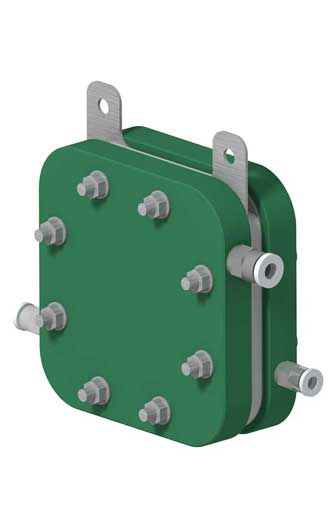 USD$999 |
USD$1199 |
USD$1399 |
USD$1799 |
USD$2799 |
USD$4799 | |
| Stack with epoxy end plate | |||||||
Stack schematic |  USD$1099 |
USD1299 |
USD$1499 |
USD$1899 |
USD$2899 |
USD$4899 | |
| Stack with epoxy end plate and temperature sensor | |||||||
Product image SS end plate |
USD$1399 |
USD$1599 |
USD$1799 |
USD$2199 |
USD$3199 (Image not available) |
USD$5199 (Image not available) | |
Current density | 0.6-3A/cm² | ||||||
| Electrode size | Cathode Φ56.5mm, Anode Φ62.5mm | ||||||
| Electrode | Nickel compoiste (not included) | ||||||
| Electrolyte | KOH, 30wt% | ||||||
| Temperature range | 15~80℃ | ||||||
| Membrane | Φ62.5mm PPS membrane (not included) | ||||||
| Polar plate material | Nickel (standard) | ||||||
| Chamber material | Engineering plastic (standard), PEEK (+USD$400) | ||||||
| End plate material | Conventional (epoxy, standard), observable (PMMA, optional), Stainless steel (+USD$400) Titanium (+USD$500), Nickel (+USD$600), Gold plated stainless steel (+USD$700), Platinzed titanium (+USD$800) | ||||||
The parameters in this table are based on the series assembly of stacks. The stacks can also be assembled in parallel or series-parallel coexistence configurations. | |||||||
Partial references citing our materials (from Google Scholar)
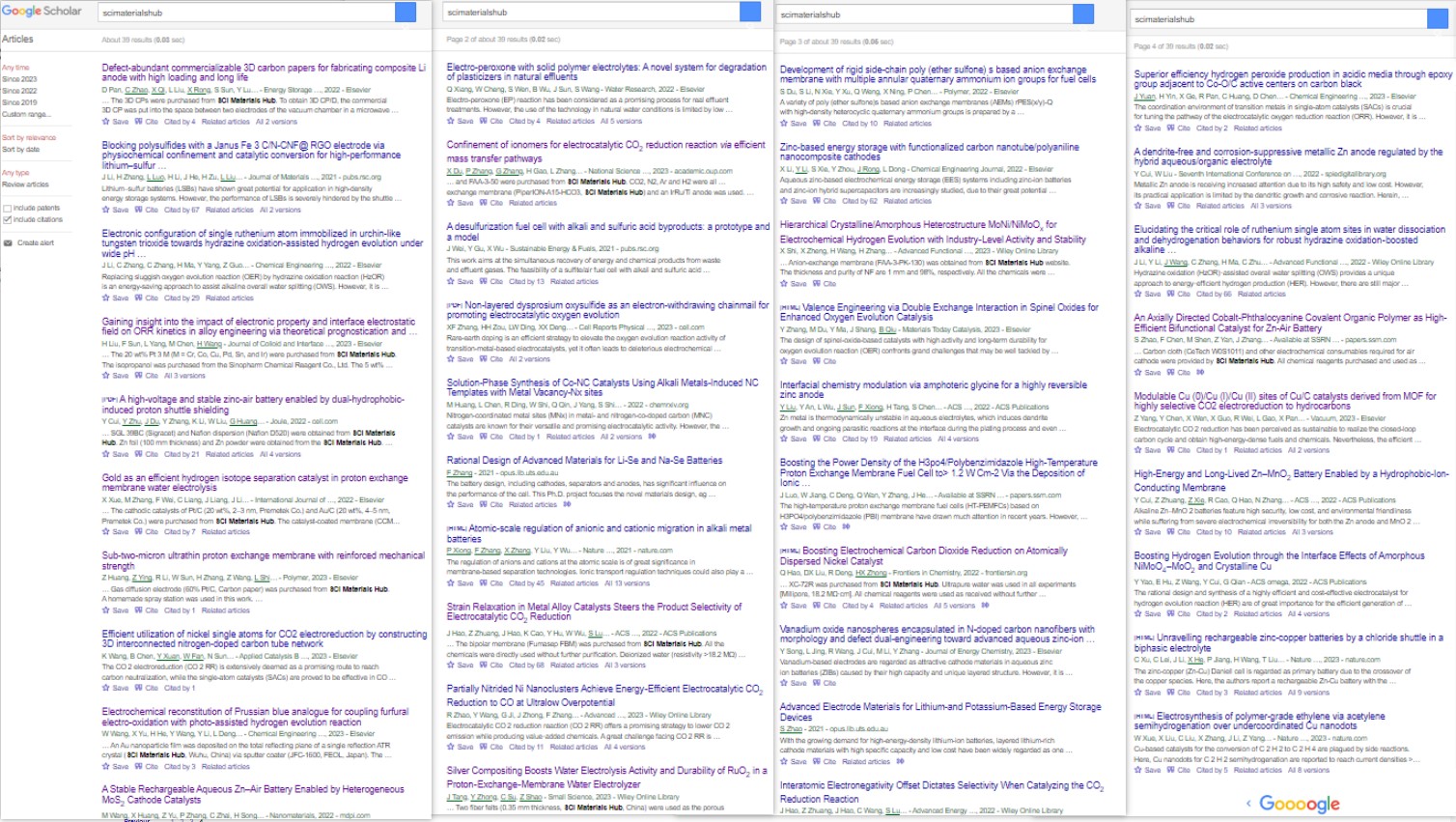
Carbon Dioxide Reduction
1. ACS Nano Strain Relaxation in Metal Alloy Catalysts Steers the Product Selectivity of Electrocatalytic CO2 Reduction
The bipolar membrane (Fumasep FBM) in this paper was purchased from SCI Materials Hub, which was used in rechargeable Zn-CO2 battery tests. The authors reported a strain relaxation strategy to determine lattice strains in bimetal MNi alloys (M = Pd, Ag, and Au) and realized an outstanding CO2-to-CO Faradaic efficiency of 96.6% with outstanding activity and durability toward a Zn-CO2 battery.
2. Front. Chem. Boosting Electrochemical Carbon Dioxide Reduction on Atomically Dispersed Nickel Catalyst
In this paper, Vulcan XC-72R was purchased from SCI Materials Hub. Vulcan XC 72R carbon is the most common catalyst support used in the anode and cathode electrodes of Polymer Electrolyte Membrane Fuel Cells (PEMFC), Direct Methanol Fuel Cells (DMFC), Alkaline Fuel Cells (AFC), Microbial Fuel Cells (MFC), Phosphoric Acid Fuel Cells (PAFC), and many more!
3. Adv. Mater. Partially Nitrided Ni Nanoclusters Achieve Energy-Efficient Electrocatalytic CO2 Reduction to CO at Ultralow Overpotential
An AEM membrane (Sustainion X37-50 Grade RT, purchased from SCI Materials Hub) was activated in 1 M KOH for 24 h, washed with ultra-purity water prior to use.
4. Adv. Funct. Mater. Nanoconfined Molecular Catalysts in Integrated Gas Diffusion Electrodes for High-Current-Density CO2 Electroreduction
In this paper (Supporting Information), an anion exchanged membrane (Fumasep FAB-PK-130 obtained from SCI Materials Hub (www.scimaterials.cn)) was used to separate the catholyte and anolyte chambers.
SCI Materials Hub: we also recommend our Fumasep FAB-PK-75 for the use in a flow cell.
5. Appl. Catal. B Efficient utilization of nickel single atoms for CO2 electroreduction by constructing 3D interconnected nitrogen-doped carbon tube network
In this paper, the Nafion 117 membrane was obtained from SCI Materials Hub.
In this paper, Proton exchange membrane (Nafion 117), Nafion D520, and Toray 060 carbon paper were purchased from SCI Materials Hub.
7. National Science Review Confinement of ionomer for electrocatalytic CO2 reduction reaction via efficient mass transfer pathways
An anion exchange membrane (PiperION-A15-HCO3) was obtained from SCI Materials Hub.
8. Catalysis Communications Facilitating CO2 electroreduction to C2H4 through facile regulating {100} & {111} grain boundary of Cu2O
Carbon paper (TGPH060), membrane solution (Nafion D520), and ionic membrane (Nafion N117) were obtained from Wuhu Eryi Material Technology Co., Ltd (a company under SCI Materials Hub).
Batteries
1. J. Mater. Chem. A Blocking polysulfides with a Janus Fe3C/N-CNF@RGO electrode via physiochemical confinement and catalytic conversion for high-performance lithium–sulfur batteries
Graphene oxide (GO) in this paper was obtained from SCI Materials Hub. The authors introduced a Janus Fe3C/N-CNF@RGO electrode consisting of 1D Fe3C decorated N-doped carbon nanofibers (Fe3C/N-CNFs) side and 2D reduced graphene oxide (RGO) side as the free-standing carrier of Li2S6 catholyte to improve the overall electrochemical performance of Li-S batteries.
This paper used more than 10 kinds of materials from SCI Materials Hub and the authors gave detailed properity comparsion.
The commercial IEMs of Fumasep FAB-PK-130 and Nafion N117 were obtained from SCI Materials Hub.
Gas diffusion layers of GDL340 (CeTech) and SGL39BC (Sigracet) and Nafion dispersion (Nafion D520) were obtained from SCI Materials Hub.
Zn foil (100 mm thickness) and Zn powder were obtained from the SCI Materials Hub.
Commercial 20% Pt/C, 40% Pt/C and IrO2 catalysts were also obtained from SCI Materials Hub.
3. Journal of Energy Chemistry Vanadium oxide nanospheres encapsulated in N-doped carbon nanofibers with morphology and defect dual-engineering toward advanced aqueous zinc-ion batteries
In this paper, carbon cloth (W0S1011) was obtained from SCI Materials Hub. The flexible carbon cloth matrix guaranteed the stabilization of the electrode and improved the conductivity of the cathode.
4. Energy Storage Materials Defect-abundant commercializable 3D carbon papers for fabricating composite Li anode with high loading and long life
The 3D carbon paper (TGPH060 raw paper) were purchased from SCI Materials Hub.
5. Nanomaterials A Stable Rechargeable Aqueous Zn–Air Battery Enabled by Heterogeneous MoS2 Cathode Catalysts
Nafion D520 (5 wt%), and carbon paper (GDL340) were received from SCI-Materials-Hub.
Carbon cloth (W0S1011) and other electrochemical consumables required for air cathode were provided by SCI Materials Hub.
Oxygen Reduction Reaction
1. J. Chem. Eng. Superior Efficiency Hydrogen Peroxide Production in Acidic Media through Epoxy Group Adjacent to Co-O/C Active Centers on Carbon Black
In this paper, Vulcan XC 72 carbon black, ion membrane (Nafion N115, 127 μL), Nafion solution (D520, 5 wt%), and carbon paper (AvCarb GDS 2230 and Spectracarb 2050A-1050) were purchased from SCI Materials Hub.
2. Journal of Colloid and Interface Science Gaining insight into the impact of electronic property and interface electrostatic field on ORR kinetics in alloy engineering via theoretical prognostication and experimental validation
The 20 wt% Pt3M (M = Cr, Co, Cu, Pd, Sn, and Ir) were purchased from SCI Materials Hub. This work places emphasis on the kinetics of the ORR concerning Pt3M (M = Cr, Co, Cu, Pd, Sn, and Ir) catalysts, and integrates theoretical prognostication and experimental validation to illuminate the fundamental principles of alloy engineering.
Water Electrolysis
1. International Journal of Hydrogen Energy Gold as an efficient hydrogen isotope separation catalyst in proton exchange membrane water electrolysis
The cathodic catalysts of Pt/C (20 wt%, 2–3 nm) and Au/C (20 wt%, 4–5 nm) were purchased from SCI Materials Hub.
2. Small Science Silver Compositing Boosts Water Electrolysis Activity and Durability of RuO2 in a Proton-Exchange-Membrane Water Electrolyzer
Two fiber felts (0.35 mm thickness, SCI Materials Hub) were used as the porous transport layers at both the cathode and the anode.
3. Advanced Functional Materials Hierarchical Crystalline/Amorphous Heterostructure MoNi/NiMoOx for Electrochemical Hydrogen Evolution with Industry-Level Activity and Stability
Anion-exchange membrane (FAA-3-PK-130) was obtained from SCI Materials Hub website.
Fuel Cells
1. Polymer Sub-two-micron ultrathin proton exchange membrane with reinforced mechanical strength
Gas diffusion electrode (60% Pt/C, Carbon paper) was purchased from SCI Materials Hub.
Characterization
1. Chemical Engineering Journal Electrochemical reconstitution of Prussian blue analogue for coupling furfural electro-oxidation with photo-assisted hydrogen evolution reaction
An Au nanoparticle film was deposited on the total reflecting plane of a single reflection ATR crystal (SCI Materials Hub, Wuhu, China) via sputter coater.

|
We Provide A Broad Range of Materials, Instruments & Solutions in Advanced Science and Technologies | About Us |



